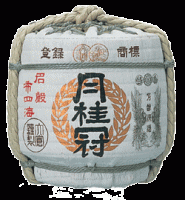
This is part one of a series of discussions on Sake. Hopefully these discussions will help you better understand, and ultimately, appreciate Sake more. Many people who have tried Sake outside of Japan often say they did not like it. It is important to remember that the quality of the rice and the purity and quality of the water have a tremendous effect on the eventual quality of the Sake. So if you have tried Sake produced from outside of Japan, it will be much different (and usually not as good due to the difference in the water) as Sake made in Japan. To truly understand Sake, you first need to understand the brewing process.
Five crucial elements are involved in brewing sake — water, rice, technical skill, yeast/koji mold, and land weather. More than anything else, sake is a result of a brewing process that uses rice and lots of water. In fact, water comprises as much as 80% of the final product, so pure water and quality rice are natural prerequisites if one hopes to brew great sake. But beyond that, the technical skill needed to pull this all off lies with the head brewers, the type of yeast they use, and the limitations entailed by local land and weather conditions.
Brewing Process Overview
Rice is washed and steamed. This is then mixed with koji (a mold known technically as aspergillus oryzae). The whole mix is then allowed to ferment, and more rice, koji, and water is added in three batches over four days, as well as the yeast. This mash is allowed to sit from 18 to 32 days, after which it is pressed, filtered and blended. This would be enough to get you through most conversations. But let us look at the main steps and processes a bit more closely.
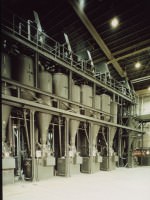
Rice Milling (Polishing)
There are particular varieties of rice used for making Sake. After proper sake rice has been secured, it is milled (or polished). This is not as simple as it might sound, since it must be done gently so as to not generate too much heat (which adversely affects water absorption) or not to crack the rice kernels (which is not good for the fermentation process). The amount of milling greatly influences the final product. The more polishing done on the rice, the better the quality of the Sake produced. The heart of the rice kernels is considered best for producing Sake. (This subject will be covered in a later discussion.)
Washing and Soaking
Next, the white powder left on the rice after polishing is washed away. Following that, the rice is soaked to attain a certain water content deemed optimum for steaming that particular rice. The degree to which the rice has been milled in the previous step determines what its pre-steaming water content should be. The more a rice has been polished, the faster it absorbs water and the shorter the soaking time.
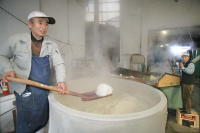
Steaming
Next the rice is steamed. This is different from the way table rice is prepared. It is not mixed with water and brought to a boil; rather, steam is brought up through the bottom of the steaming vat to work its way through the rice. This creates a firmer consistency, as well as a slightly harder outside surface and softer center. Generally, a batch of steamed rice is divided up, some having koji mold sprinkled over it, and some going directly to the fermentation vat.
Koji Making
This is the heart of the entire brewing process, and could have several books written about it. Rice, unlike grapes, does not contain sugars. Without sugar, fermentation would not be possible. The koji mold contains an enzyme which breaks down the starch in the rice into sugars allowing fermenatation to take place.
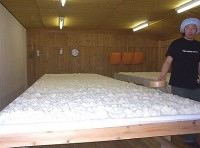
Summarizing, koji mold in the form of a dark, fine powder is sprinkled on steamed rice that has been cooled. It is then taken to a special room within which a higher than average humidity and temperature are maintained. Over the next 36 to 45 hours, the developing koji is checked, mixed and re-arranged constantly. The final product looks like rice grains with a slight frosting on them, and smells faintly of sweet chestnuts. Koji is added at least four times throughout the process, and is always made fresh and used immediately.
The Yeast Starter
A yeast starter, or seed mash of sorts, is first created. This is done by mixing finished koji and plain steamed white rice from the above two steps, water and a concentration of pure yeast cells. Over the next two weeks, a concentration of yeast cells that can reach 100 million cells in one teaspoon is developed.
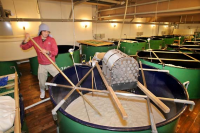
Fermentation
After being moved to a larger tank, more rice, more koji and more water are added in three successive stages over four days, roughly doubling the size of the batch each time. This is the main mash, and as it ferments over the next 18 to 32 days, its temperature and other factors are measured and adjusted to create precisely the flavor profile being sought.
Pressing
When everything is just right, the sake is pressed. Through one of several methods, the white sediment and unfermented solids are pressed away, and the clear sake runs off. This is most often done by machine today. Older methods involved putting the mash in canvas bags and squeezing the fresh sake out, or letting the sake drip out of the bags.
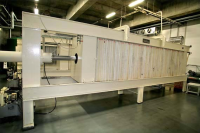
Filtration
After sitting for a few days to let more solids settle out, the sake is usually charcoal filtered to adjust flavor and color. This is done to different degrees at different breweries, and has a large effect on the eventual style of the Sake.
Pasteurization
This process kills off bacteria and deactivates enzymes that would likely adverse flavor and color later on. Sake that is not pasteurized is called namazake, and maintains a certain freshness of flavor, although it must be kept refrigerated to protect it.
Aging
Finally, most sake is left to age about six months, rounding out the flavor. It is then mixed with a bit of pure water to bring the near 20 percent alcohol content down to about 16 percent, and blended to ensure consistency. It is usually pasteurized a second time at this stage.
Changes Over the Years
Over the centuries, naturally there were many changes to the sake brewing process. These changes arose to either make better sake, or to make sake more economically.
One of the most important advances was the improvement in rice-polishing equipment. Originally, rice in a vat was stomped on to remove the husks. Later, water wheels and grinding stones were used. Today, there are large computer-controlled machines that polish off the specified percentage of the outside of the grains, and do it in a specified amount of time.
Another major advance was the use of ceramic-lined or stainless steel tanks, now the standard, over cedar tanks, which were used for hundreds of years during the fermentation process. This has drastically improved the quality and purity of sake.
Then there is the pressing stage. Until the early 1900’s, all sake was pressed by pouring the fermented mash into canvas bags which were then put into a large wooden box. The lid was then cranked down into the box, squeezing out the sake. Now, almost all sake is pressed with a huge, accordion-like machine that squeezes the mash between balloon-like inflating panels.
Almost all breweries will still press some of their best sake in the old way. It does make subtly better sake. But the newer accordion-like machine is so much more efficient, and the older methods are so labor intensive, that the tradeoffs are only worth it for top-grade sake.
The slightest differences in the koji can affect the flavor of the final product. Traditionally, koji was all made by hand in wood-paneled rooms kept warm and humid. However, this was very labor -intensive. There are now large machines that will perform part or all of the koji making process, doing the work of several individuals. There are countless manifestations of these, all attempting to imitate the skill and intuition of the human masters. Other changes include stainless steel walls instead of wood walls. The risk of the development of unwanted mold is reduced, but humidity is affected. In the end, there are countless arguments for and against these changes. Subtle changes in daily temperature and rice quality may not always be picked up by machines, but sanitation can be greatly improved upon. Naturally, technological progress to some degree is necessary for the industry to survive. There are still many small, local “micro breweries” that still brew Sake using the traditional methods.





